The social activism of the 1960s and 1970s gave rise to an “underground press,” which provided an alternative way to publish writings on a variety of issues, including Black empowerment, the quest for civil liberties and workers’ rights, anti-Vietnam war sentiment, and critiques of capitalism. This was not a single press but rather a loose collection of independent magazines, alternative newspapers, fringe book publishers, and printing cooperatives, which helped democratize publishing by making the necessary equipment and processes available to ordinary citizens. Alternative presses were created to bypass reluctant commercial printers who simply did not agree with the ideas expressed or feared boycotts by the public or from other clients, as well as reprisals from the government.
Detroit became a hub for such alternative thinking and publishing, both before and after the wake of the citizen uprisings against institutionalized anti-Black racism in 1967 as well as on the basis of its strong union presence in manufacturing. In 1969, a group of friends, including Fredy and Lorraine Perlman, purchased a used industrial printing press and set up shop in the city, eventually calling themselves the Detroit Printing Co-op.
Although lacking any formal printing or design training, Fredy Perlman found an innate connection to the visual possibilities of the printed page. His printing experiments ranged from creating striking collages and using overlapping ink colors to inventive treatments for texts and images on the page. Rejecting the convention of privately owned property, the Co-op also made its press available for like-minded others to use, and printed paid commissions to help cover expenses. The Co-op’s activities included Fredy and Lorraine Perlman’s book imprint called Black & Red, which published Guy Debord’s seminal text, Society of the Spectacle; printing one of the era’s defining magazines, Radical America; and collaboration with members of Black Star, the publishing arm of the League of Revolutionary Black Workers, and Detroit’s influential anarchist newspaper Fifth Estate.
The story of the Detroit Printing Co-op underscores the power of the press to voice dissent, organize communities of like-minded individuals, and to articulate a case for social change. In an era dominated by the printed word and graphic communications, the Detroit Printing Co-op offered a small but potent example of such power, one that finds echoes not only in some of today’s pressing social issues, but also in the resurgent interest in self-publishing and alternative printing methods in an age of screen-based social media
For more information about The Detroit Printing Co-op: The Politics of the Joy of Printing, click here.
Detroit Printing Co-op: The Politics of the Joy of Printing is based on a previous exhibition produced by 9338 Campau and subsequent research for a publication of the same title by Danielle Aubert, which was supported in part by the James L. Knight Foundation, Wayne State University, and AIGA. The exhibition was organized by Cranbrook Art Museum and was curated by Andrew Blauvelt and Danielle Aubert with exhibition design by Jon Geiger.
Headspace: Jim Dine’s Glyptotek
Inspired by a 1984 trip to Glyptothek, Munich’s museum dedicated to antique Greek and Roman sculpture, artist Jim Dine set out to create a book of prints inspired by the collection. He produced forty drawings uniquely designed to function as transparencies in the production of héliogravure prints, a printmaking process used to reproduce the earliest photographs. Dine’s prints exist both as individual works and as a collection, bound together in the oversized book, Glyptotek. According to Dine, each individual image in his Glyptotek can stand alone, but when viewed together they form a singular narrative “about learning from the Ancient World.”
Headspace pairs Dine’s prints with sculptural works by other artists from Cranbrook Art Museum’s permanent collection. These pieces from the twentieth century draw aesthetic parallels to Dine’s gestural renderings. Many of the selected busts mimic Dine’s ancient source material, while other works abstract the figure and reduce the form to a simple suggestion of it represents.
Headspace: Jim Dine’s Glyptotek is organized by Cranbrook Art Museum and curated by Kat Goffnett, the Jeanne and Ralph Graham Collections Fellow, and features works gifted by George Francouer and Gerald Earles.
Allie McGhee has been an important pillar of the Detroit art scene for more than five decades with a practice defined by his signature approach to abstraction. This retrospective is a long overdue presentation of significant past works from McGhee’s extensive and dynamic oeuvre, as well as the premiere of ambitious new paintings created for this auspicious occasion.
In the late 1960s, McGhee shifted his practice from representational depictions because he was drawn to the long communicative history of geometry and abstraction in the timeline of humanity. One constant inspiration has been traditional African sculpture and its forms of symbolism. The title of this exhibition—Banana Moon Horn—is the name McGhee has given to the recurring arcing forms that he has explored throughout his career. The Banana Moon Horn has associations ranging from the natural world, humor, and ancient art—myriad interpretations are both intentional and welcome. McGhee often overlaps and mixes mediums by incorporating found objects or bringing a three-dimensional quality to his paintings. To this end, his collapsed canvas works have conceptual ties to McGhee’s research into science and the cosmos, often alluding to the view into a microscope or possibly collapsing universe.
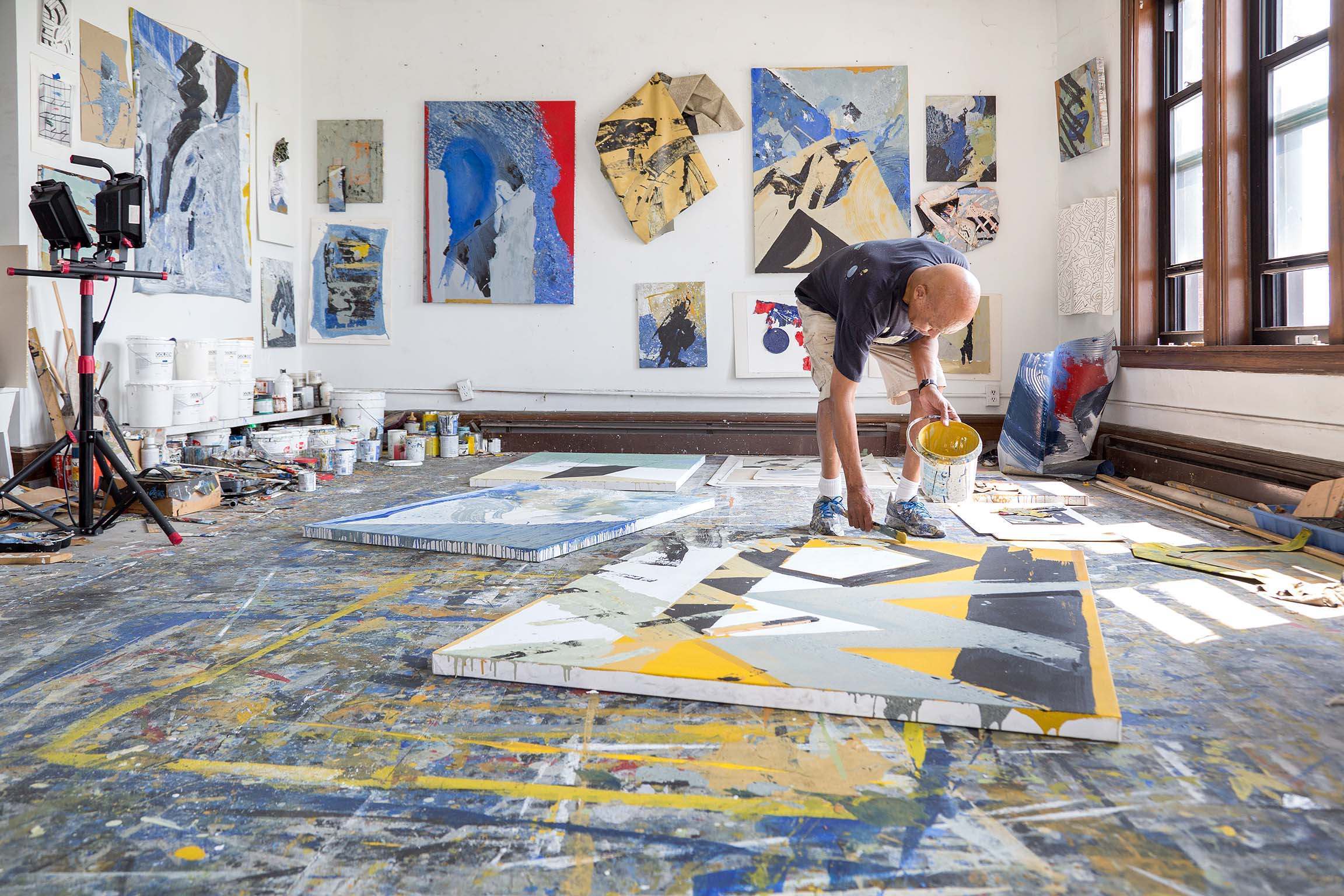
Hailing from Flint, Michigan, Tunde Olaniran is a multi-disciplinary artist, musician, singer and performer. Beginning in 2019, the museum partnered with Olaniran to help create their most ambitious project to date—the short film and exhibition Made a Universe. Olaniran worked with Detroit-based artists to create the film’s scenography, costuming, and props. These elements are re-imagined in the galleries along with a screening room, offering visitors an immersive, parallel journey through Olaniran’s creative universe.
With the narrative arc of a hero’s journey, this contemporary horror film takes its inspiration from archetypes like those found in storylines from The New Mutants, an X-Men spin-off comic book series. Within this premise, the character’s often perceived weakness translates into their unique superpower. The film examines what it means to unlock your power in the face of fear and repression, and how one must unify various fragments of their psyche to connect with the world and themselves on a deeper level.
The series, shot on location throughout Detroit, is co-written, directed, and scored by Olaniran and Paige Wood, and features collaborations across artistic mediums with several multidisciplinary, award-winning artists, including Yo-Yo Ma, Ellen Rutt, Natasha Beste, Lisa Waud, Amy Fisher-Price, Emma Davis, Skyylar Taylor, Talicia Campbell, Matthew Osmon, Terra Lockhart, Rachelle Baker, and Katy Dresner.
An experimental short film and 4D installation featuring original music from Tunde Olaniran and Yo-Yo Ma, and new work conceptualized by artists Ellen Rutt, Lisa Waud, Amy Fisher-Price, Skyylar Taylor, Natasha Beste, and Emma Davis.
STARRING
TUNDE – Tunde Olaniran
LEON – Andrew Otchere
MIKE – Michael Hatten
AARON – Segun “Delusion” Delu
BREE – Morgan Hutson
TIAH – Ash Arder
GLADYS – Carol
MW EVELYN – Ann Burns
RYAN – Richard Newman
DANCERS
Segun “Delusion” Delu, Bree Gant, Celia Benvenutti, Derrick Finley.
CREW
Director – Tunde Olaniran
Producer – Paige Wood
Co-Writers – Tunde Olaniran and Paige Wood
Cinematographer / DP – Jeremy Brockman
Art Director / Editor – Katy Dresner
Field Producer – Ryah Aqel
Assistant Director – Jackson Ezinga
First Assistant Camera – Abigail Lynch
Steadicam Operators – @steadibart and Greg Johnson
DIT / Assistant Editor – Nadeem Persico-Shammas
Gaffer – Justin Ward
Key Grip – Andy Westra, Caleb Richardson
Dolly Grip – Costa Kazaleh Sirdenis
Swing – Kirk Yoshonis, Caleb Richardson
Sound Recordist – Wayne Ramocan Jr.
Set Design: Ellen Rutt, Lisa Waud, Amy Fisher-Price, Natasha Beste, Katy Dresner
Assistant Art Director – Duncan Burns
Materials Research – Alana Weiss-Nydorf
SFX Coordinators – Devin Durocher, David Baile
Production Assistants – Karen Cardenas, Costa Kazaleh Sirdenis, Kat Goffnet, Meredith Walker, Josue Fierro, Abigail Barnett
Camera Equipment Provided By – Stratton Camera
Lighting Equipment Provided By – Courtesy Flag LLC., Detroit Power and Light
Key Hairstylist – SaRyn Byers-Johnson
SFX Make-Up – Miranda Collins Assistant
MUAs (to Skyylar Taylor) – Naomi Zeman, Jordan Stephens
Clothing and Jewelry Provided By – SMPLFD, Noir Leather, SKNDLSS, Devon Parrott Titles – Matthew Osmon RAIVAN
Original Artwork – Matthew Osmon, Rachelle Baker Catering: Fried Chicken and Caviar, Stay Fresh Express
SPECIAL THANKS to The Library Street Collective, The Jam Handy, Foster Financial, and Said and Wadha Aqel for allowing us to film in your space(s).
Produced in conjunction with Cranbrook Art Museum and curated by Chief Curator, Laura Mott. Made possible through support from The Knight Foundation, The National Endowment of the Arts, The Library Street Collective, Jennifer and Dan Gilbert, and Don Manvel.
Tunde Olaniran: Made A Universe is organized by Cranbrook Art Museum and curated by Chief Curator, Laura Mott. The film series is produced by Paige Wood. The project is generously supported by The John S. and James L. Knight Foundation, the National Endowment for the Arts, Jennifer and Dan Gilbert, Don Manvel, and additional support by Library Street Collective.
Tunde Olaniran: Made A Universe is presented by Flagstar Bank.


Olga de Amaral, one of the most recognized names in Latin American art, lives and works in her native Bogotá, Colombia. Tracing the artist’s career over five decades, Olga de Amaral: To Weave a Rock is the artist’s first major museum retrospective in the United States, consisting of some 60 works that elucidate her seminal influence and technical innovations. The artist was first introduced to the medium of fiber during her studies with Marianne Strengell at Cranbrook Academy of Art from 1954-1955. Since that time her work has prolifically evolved beyond the functional qualities of weaving into more experimental and sculptural woven forms.
Amaral’s woven sculptures are the result of a lifetime of experimentation and material studies drawing on techniques like plaiting and wrapping, using materials as varied as horsehair and gold leaf. Amaral has formed a unique visual language of abstraction that draws upon Colombia’s landscape and history as well as the artist’s own identity. Taking its title from an assignment Amaral had given to her students at the famed Haystack craft school in 1967, the exhibition Olga de Amaral: To Weave a Rock poetically expounds on her expansive views of textile practice. Still practicing in her eighties, Olga de Amaral’s work offers a prescient exploration of the expressive potential of fiber at a moment of renewed interest in the medium by contemporary artists and historians alike.
Shapeshifters explores the artist’s ability to redefine themselves, transgress their chosen medium, and transcend the world around them in utterly unique ways. Through the lens of artistry, these transformations are examined in a broad range of artworks from the museum’s permanent collection, presented in four galleries, each with a distinct focus. “Freeze Frame” panels are located throughout the galleries that focus on specific artists and tell their stories of artistic risk and innovation.
Hard Edge/Blurred Lines considers abstraction as an aesthetic strategy to unearth a wealth of individual approaches and philosophies, ranging from ancient sacred geometries to urgent societal concerns. For instance, post-war artists such as Jo Baer and Agnes Martin embrace their own versions of abstraction as a form of visual language that transcend patriarchal narratives—beyond nation, gender, and societal hierarchy. Martin in particular saw her work as a lineage from ancient Egyptian, Chinese, Greek, and Arabic artists. Similarly, Ato Ribeiro (Cranbrook Academy of Art ’17) creates wooden compositions that are informed by the ancestral communication set into the patterns of Ghanaian Kente cloth and African American quilts. Alternately, an adjacent gallery investigates the amorphous possibilities of abstract painting to create an alternate expression of the world. Processes that embrace movement and spontaneity are evident in the work of Joan Mitchell, Sam Gilliam, and José Joya, while the painterly glazed surfaces of ceramicist Toshiko Takaezu are experimental collaborations with the fire of the kiln.
If abstraction in art promised to transcend conventional depictions of reality, then photography offered to capture it. But such an expectation are subverted by artists who use photographic processes and images in their work to expand the definition of their respective medium. Exploding the Frame presents artworks that utilize alternative methods and unconventional strategies. For example, Brittany Nelson (CAA ’11) employs camera-less photography based on nineteenth-century darkroom techniques, merging them with the digital to expand photography beyond the representational, while Robert Rauschenberg’s collage-based works appropriate images from existing photographs to bridge the gap between documentation and invention.
Transformation as an act of claiming agency and asserting dignity in contemporary art is thematically explored in Sea Change. Through processes of foregrounding, altering, shielding, and abstracting the human figure, these artists create works that psychologically mirror the complexity of societal constructs and inequalities. Richard Yarde brings center stage larger than life figures from African American culture, setting them in the scale of monumental portraiture historically reserved for colonizers. From a new generation of masterfully skilled figurative painters, Conrad Egyir (CAA ’18) presents himself in three different shades of skin color challenging the systemic hierarchies of identity, while Marianna Olague’s (CAA ’19) portraits feature individuals from her personal history living on the US-Mexico border, giving prominence to those often marginalized.
Exhibited for the first time at the museum, Nick Cave’s (CAA ’89) Up Right: Detroit is a short film created during the artist’s exhibition and performance series Nick Cave: Here Hear in 2015. Commissioned by Cranbrook Art Museum, the film features a powerful transformation of selfhood orchestrated with participants from the Ruth Ellis Center, a center for LGBTQ+ youth, and the Mosaic Youth Theatre from Detroit. In a rite of passage ceremony, “Practitioners” dress “Initiates” in Cave’s canonical Soundsuits created especially for this work. The participants undergo a metamorphosis through the initiation, emerging as strong and fearless beings.
Shapeshifters features works from the collection by Richard Anuszkiewicz, Jo Baer, Ebitenyefa Baralaye, Romare Bearden, McArthur Binion, Susan Goethel Campbell, Anthony Caro, Nick Cave, Nicole Cherubini, Sonya Clark, Liz Cohen, Conrad Egyir, Beverly Fishman, Kottie Gaydos, Sam Gilliam, Kara Güt, Carole Harris, Matthew Angelo Harrison, José Joya, Donald Judd, Agnes Martin, Allie McGhee, Marilyn Minter, Brittany Nelson, Kenneth Noland, Marianna Olague, Robert Rauschenberg, Ato Ribeiro, James Rosenquist, Beau Sinchai, Julian Stanczak, Frank Stella, Maya Stovall, Toshiko Takaezu, Carl Toth, Kara Walker, Andy Warhol, and Richard Yarde, among others.
Purchase general admission here.
For more information about Shapeshifters: Transformations in Contemporary Art, click here.
Shapeshifters is indebted to the significant gifts on view from the Dr. John and Rose Shuey Collection, the Andy Warhol Foundation for the Visual Arts, and recent acquisitions from the Estate of George Francoeur and Gerald Earls.
Cranbrook Art Museum is generously supported by the Maxine and Stuart Frankel Foundation, the Fred A. and Barbara M. Erb Foundation, the Kresge Foundation, the MASCO Foundation, and the Museum Committee and ArtMembers at Cranbrook.
The most innovative work from the next generation of architects, artists, and designers will be on display at the 2021 Graduate Degree Exhibition of Cranbrook Academy of Art. The Degree Exhibition showcases pieces that are the culmination of two years of studio work from a diverse group of graduates as they launch their careers.
The show opens to the public on Sunday, April 18, with a special ArtMembers Preview Day on Saturday, April 17. In compliance with safety and health regulations, all visits must be scheduled in advance.
In 1932, a remarkable educational experiment opened on the Cranbrook campus in the suburbs of Detroit, a new Academy of Art for advanced studies in the visual arts. Described by the New York Times as “part laboratory, part atelier, and part artist’s colony,” Cranbrook Academy of Art dedicated itself to the education of artists, architects, designers, and craftspeople. Rooted in the contemporary, its mission and vision was simple: to support the individual artist’s search for an expression unique and resonant to her time. Widely considered the cradle of mid-century design in America, the Academy quickly became a national and international leader, a reputation that holds true today as one of the top-ranked programs of its kind in the world.
Conceived as a radical experiment in the education of artists, Cranbrook Academy of Art rejected the academic and theoretical focus of arts education of the day and instead embraced individual creativity and expression through the actual making of work as a cornerstone of its philosophy. It encouraged the exploration of alternative materials, innovative processes, and new ideas across disciplines through both self-education as well as collaboration with peers. In this way, it was and remains a student-centric pedagogical environment.
The Academy not only pioneered a more organic and human-centric approach to modern design in America starting in the 1930s and helped shape the Studio Craft movement in America in the postwar period, but also radicalized the fields of architecture and design in the 1980s during the advent of postmodernism. Although many schools of radical art and design emerged in the twentieth century–places such as the Bauhaus or Black Mountain College–only Cranbrook Academy of Art remains today as a vital force in the worlds of art, architecture, craft, and design.
With Eyes Opened, surveys the history of the Academy since its official founding in 1932. With more than 250 works representing the various programs of study at the school–architecture, ceramics, design, fiber, metals, painting, photography, printmaking, and sculpture–the exhibition occupies all of the museum’s galleries. The largest such examination of the Academy since the landmark 1983 exhibition, Design in America, With Eyes Opened will be accompanied by a 600-plus page publication that chronicles the history of this storied institution and will feature 200 alumni representing the various programs of study, both historical figures and emerging voices, who have made remarkable contributions to the visual arts.
The exhibition is organized into a series of nine galleries that highlight the Academy’s contributions to the fields of art, architecture, craft, and design.
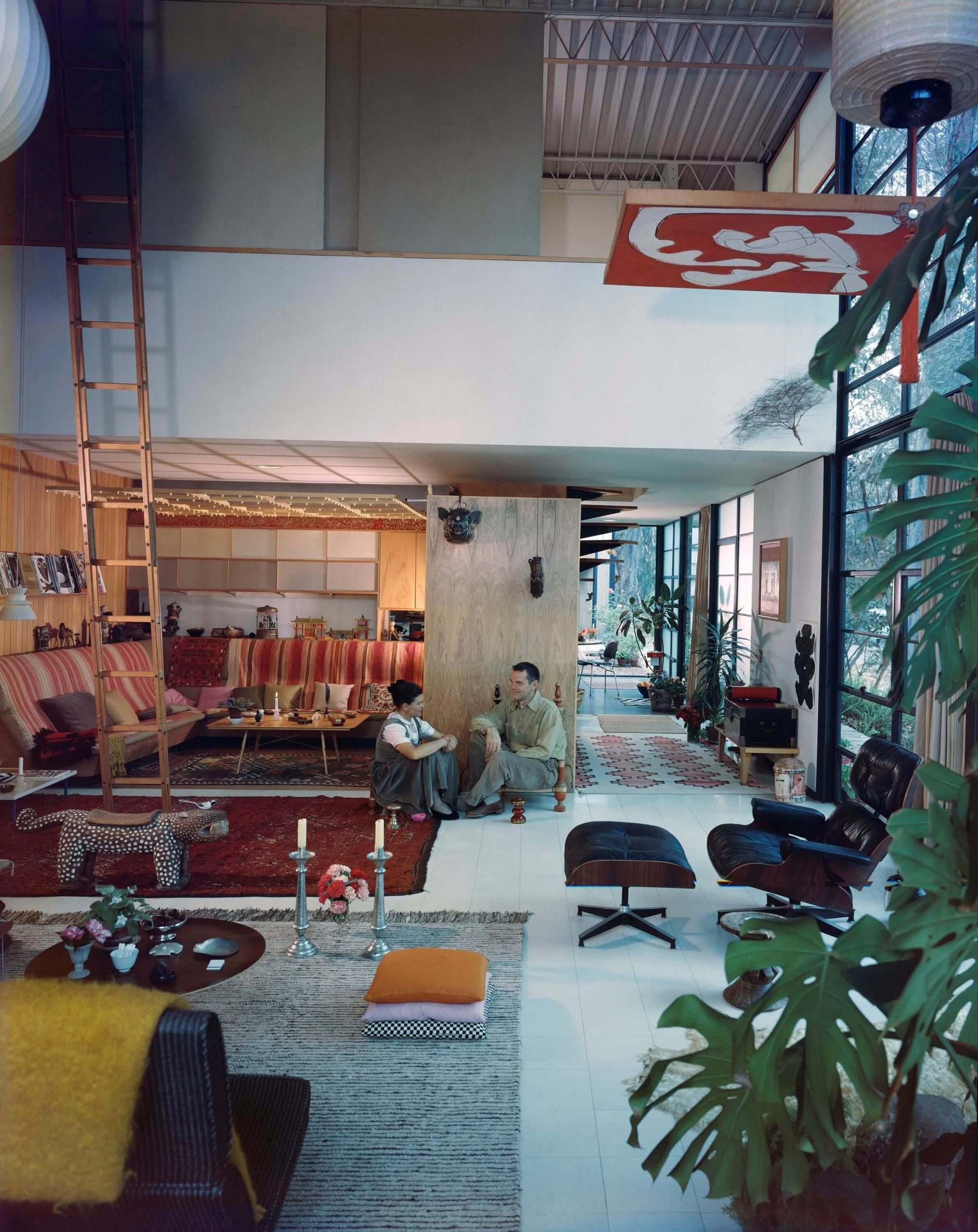
Florence Knoll would revolutionize modern office design for corporate America. Her friends at Cranbrook, such as Harry Bertoia and Eero Saarinen would introduce now-iconic furniture pieces for her company, Knoll International. This hotbed of talent would incubate a particularly American version of modern design, earning the Academy the moniker of the “cradle of mid-century modernism.”
These innovators would be followed by other designers such as Ruth Adler Schnee, Gere Kavanaugh, Clyde Burt, and John Risley, all of whom embraced wit and whimsy. The sculptural and expressive Brutalist furniture of artists such as Paul Evans continues through the contemporary designs of Chris Schanck and Jack Craig. Radical experiments in furniture, such as Urban Jupena’s fibrous lounge seating element, Ken Isaacs’ build-it-yourself Superchair, and an early pioneer of human-centered design and ergonomics—Niels Diffrient’s Humanscale each charted new design horizons.
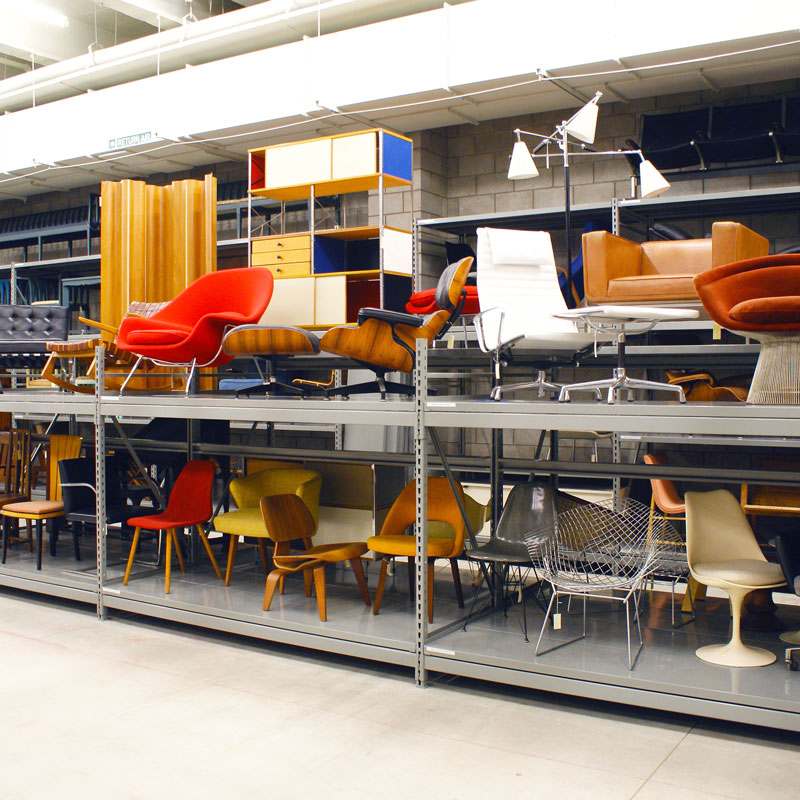
Cranbrook dominated the genre of stacking chairs, with innovations by Don Albinson, whose clever design kept a stack of chairs in perfect alignment, David Rowland, who created a high-density stacker, and Hugh Acton, who designed the first ergonomic stacking armchair. Office task chairs were created by former Designer-in-Residence Michael McCoy, and alumni Niels Diffrient, and Charles and Ray Eames.
Cranbrook and the Chair celebrates artist-designed furniture, which has also been pioneered by the Academy through the work of Terence Main, Chris Schanck, Jonathan Muecke, Vivian Beer, Jack Craig, Jay Sae Jung Oh, and Evan Fay, among many others.
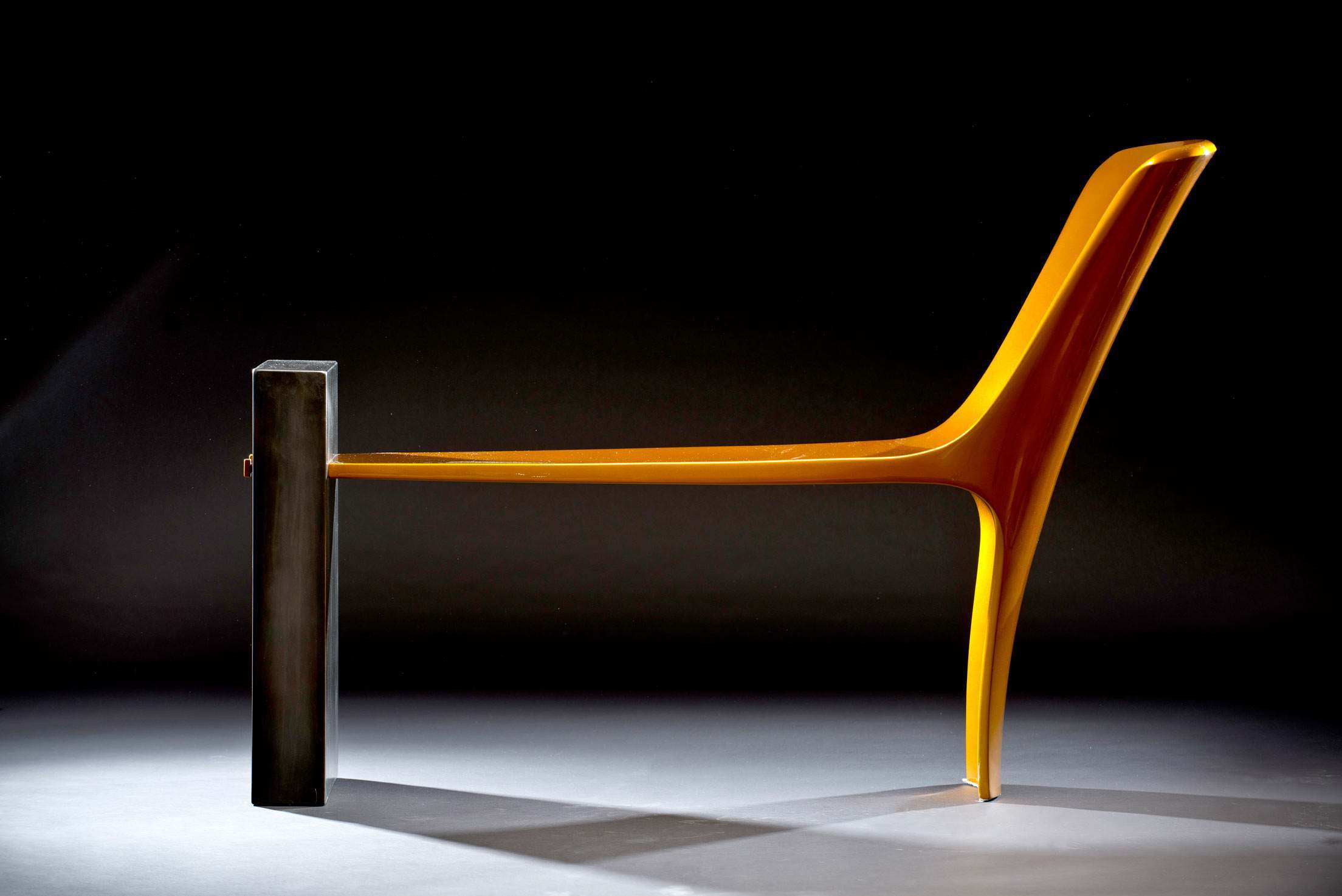
Although the age of the artists shown in this gallery is separated by nearly a half-century, there is shared energy that captures how artists can push boundaries and transcend disciplines in their search for the new.
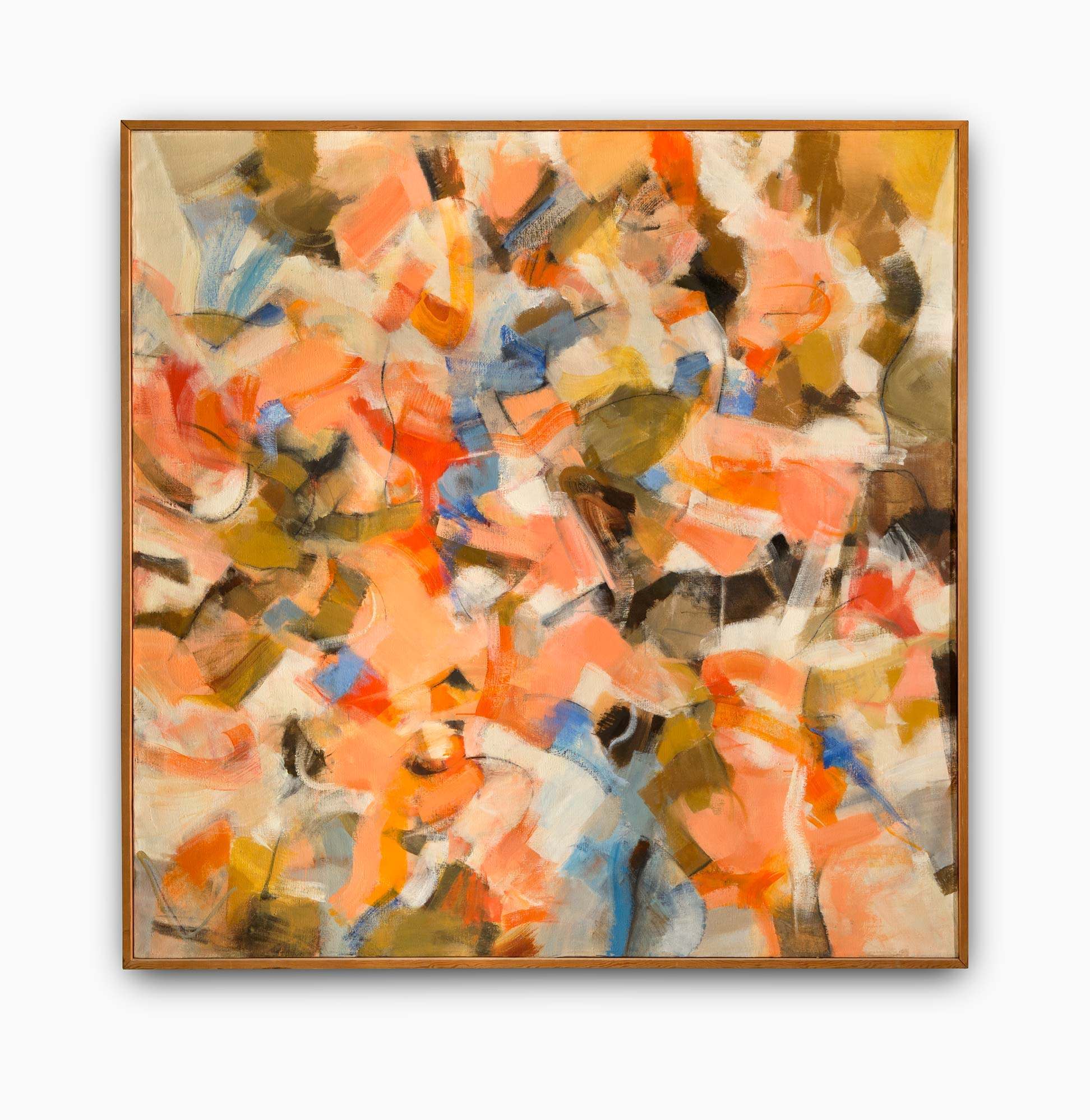
As a complement to the figurative work of artists-in-residence Carl Milles and Zoltan Sepeshy, abstraction would enter the Academy through artists such as Harry Bertoia, and painting instructor Wallace Mitchell. Alumni such as José Joya, Frank Okada, and Wook-kyung Choi devoted their painting practices to abstraction. The canvas itself becomes a shaped figure in the work of artist-in-residence George Ortman, John Torreano, and artist-in-residence Beverly Fishman, whose pieces attain sculptural depth and symbolic meaning.
The materiality of painting is foregrounded in works by Jessica Dickinson, Rosalind Tallmadge, and James Benjamin Franklin, each of whom enhance painting’s tactile dimension through substances like plaster, epoxy, sand, sequin fabric, or carpet.
In the 1980s, Carl Toth used the photocopier machine as a camera, combining images through collage. Contemporary artists such as Sheida Soleimani and Chanel Von Habsburg-Lothringen use photomontage to explore themes of violence and gender, while the camera-less images of Brittany Nelson use antique photographic processes to create alternative imagescapes.
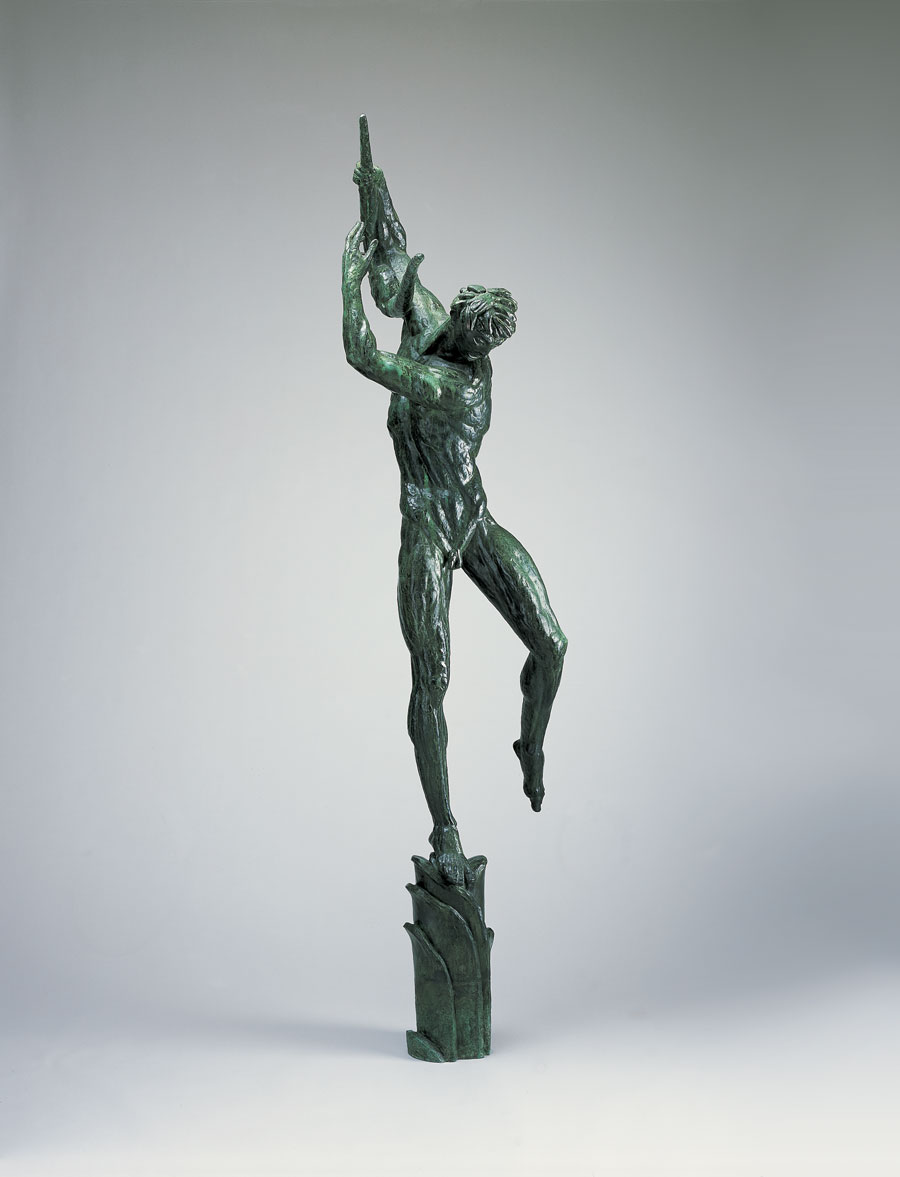
The scale and freedom of sculpture appealed to students in other departments as well, particularly the crafts. Large-scale fiber works by Olga de Amaral, Sonya Clark, and Nick Cave are complemented by the ceramics of Toshiko Takaezu and artist-in-residence Jun Kaneko. Even the practice of architecture at Cranbrook is akin to sculpture, as seen in the designs of Eero Saarinen and contemporary practitioners, such as Hani Rashid.
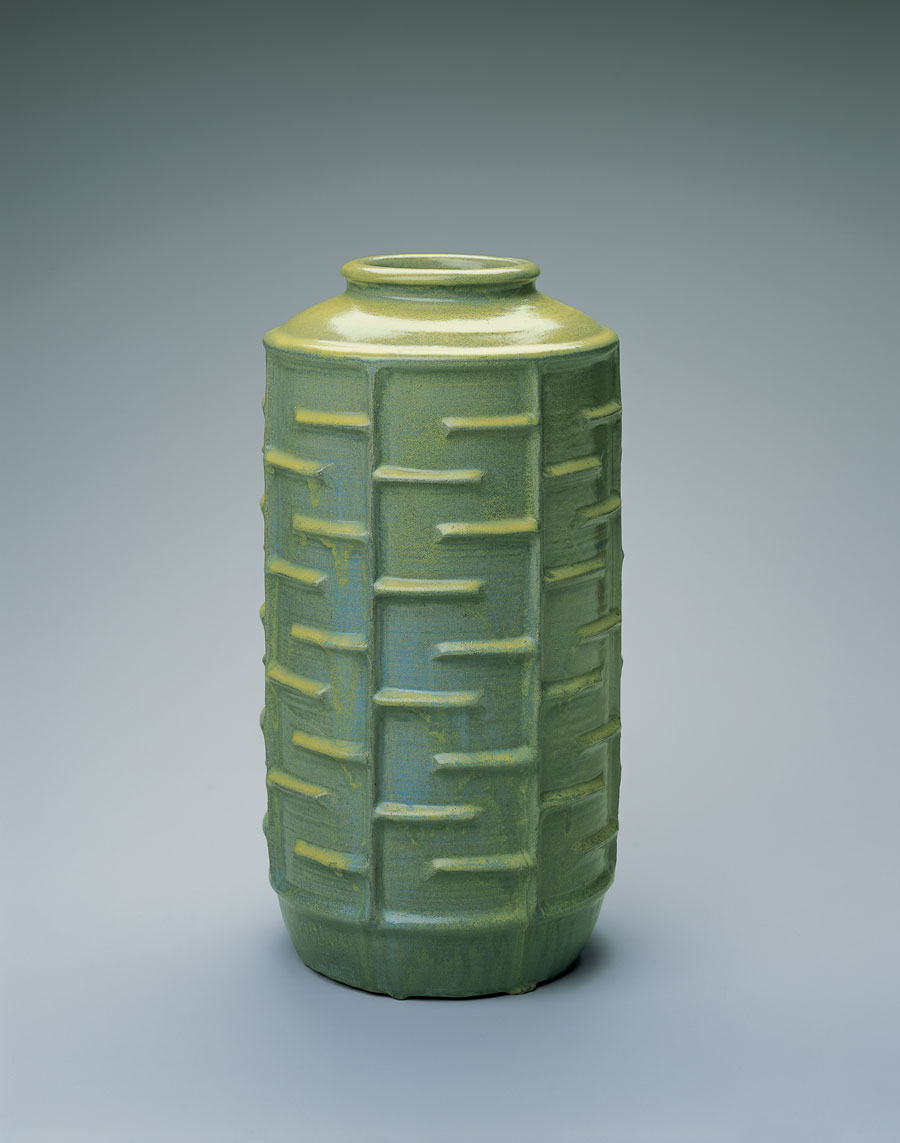
Although described by their respective materials, each discipline has exceeded such boundaries, as witnessed by ceramicists such as artist-in-residence Richard DeVore, Annabeth Rosen, and Marie Woo. In Metals, Myra Mimlitsch-Gray explores the social history of the material, while an artist such as Chunghi Choo has perfected the ability to sculpt her fluid forms in metal. Artists such as Joan Livingstone and Anne Wilson continue to push the boundaries of the field of fiber.
The desire to upend expectations can be seen in the “anti-jewelry” of J. Fred Woell or in the work of artist-in-residence Iris Eichenberg; the radical basket weaving of Lillian Elliott and her mentor Ed Rossbach; or the creation of the field of studio glass by Harvey Littleton, who had studied Ceramics. Even in the design fields, the influence of crafts can be found in the experimental use of materials and techniques and the beauty of handcrafted product design models made before the era of 3D printing and computer modeling.
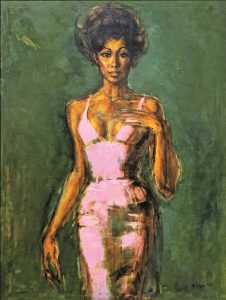
Cranbrook artists continue to re-conceptualize the portrait through painting, sculpture, and photography, reinventing the traditional genre through a contemporary lens.
Work by Zoltan Sepeshy and Artis Lane shows each one’s approach of capturing the sitter’s essence through a figural likeness. Painter Charles Pachter has collaborated with his friend author Margret Atwood, capturing her spirit on canvas. Marianna Olague, Jova Lynne, and Conrad Egyir explore the social and political underpinnings of portraiture while reclaiming space for their subjects.
Corine Vermeulen and Liz Cohen use the documentary style of photography, but add their contemporary interpretations to transform the work into narratives of their subjects while Shanna Merola and Ricky Weaver employ the techniques of collage and doubling respectively to disrupt distinct identities. Shiva Ahmadi infuses the Persian tradition of miniature painting with social critique while Sarah Catherine Blanchette subverts familiar forms in favor of fragmentation and re-materialization, turning photos into luxurious fiber.
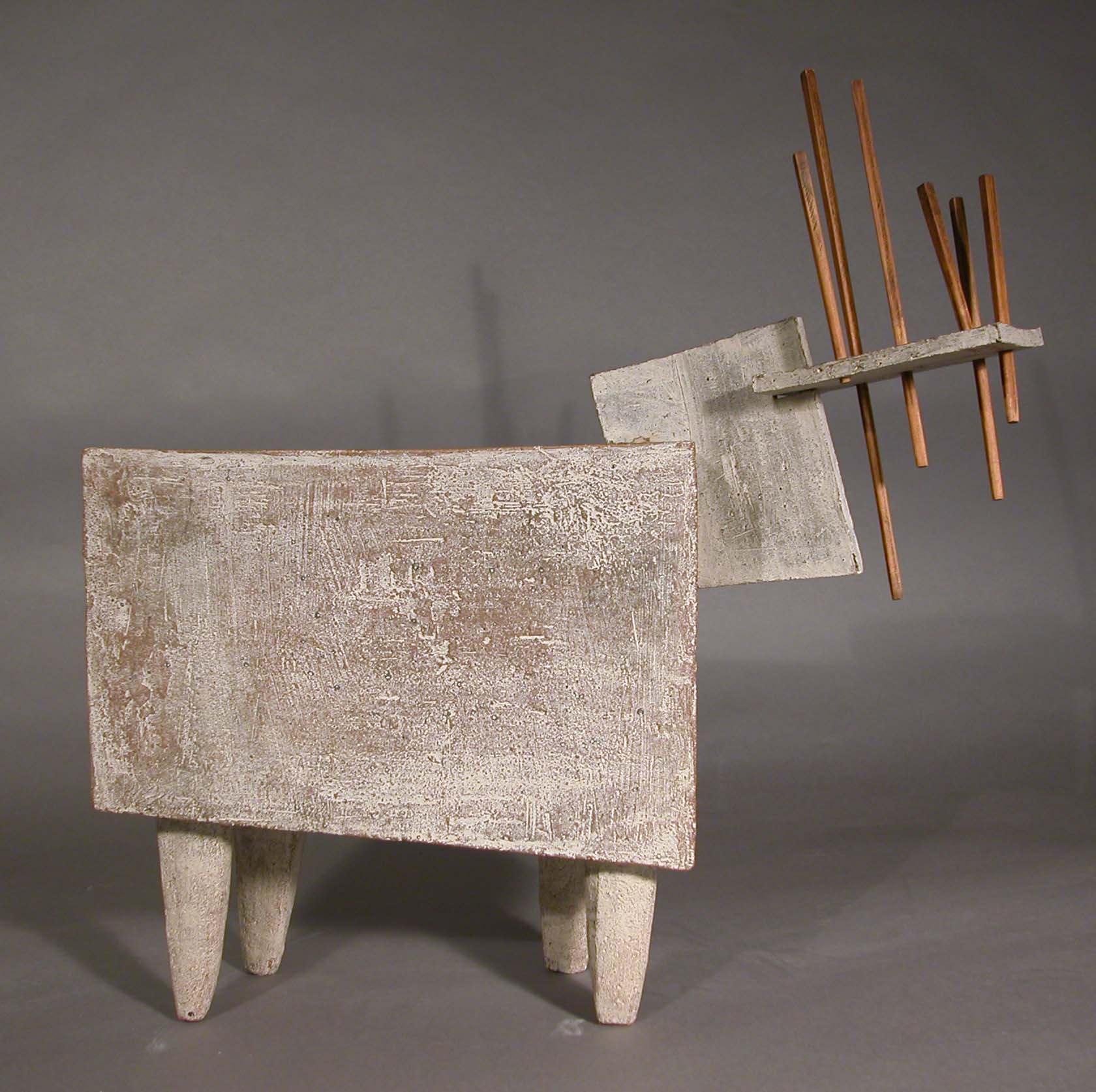
This gallery extends the collection beyond the museum walls, showcasing sketches for many of the naturally-inspired works found on Cranbrook’s campus, from the Milles’ sketches for both Europa and the Bull and Running Dogs to small decorative elements such as Fredericks’ water spigots which take the shape of a Japanese goldfish, lizard, and frog.
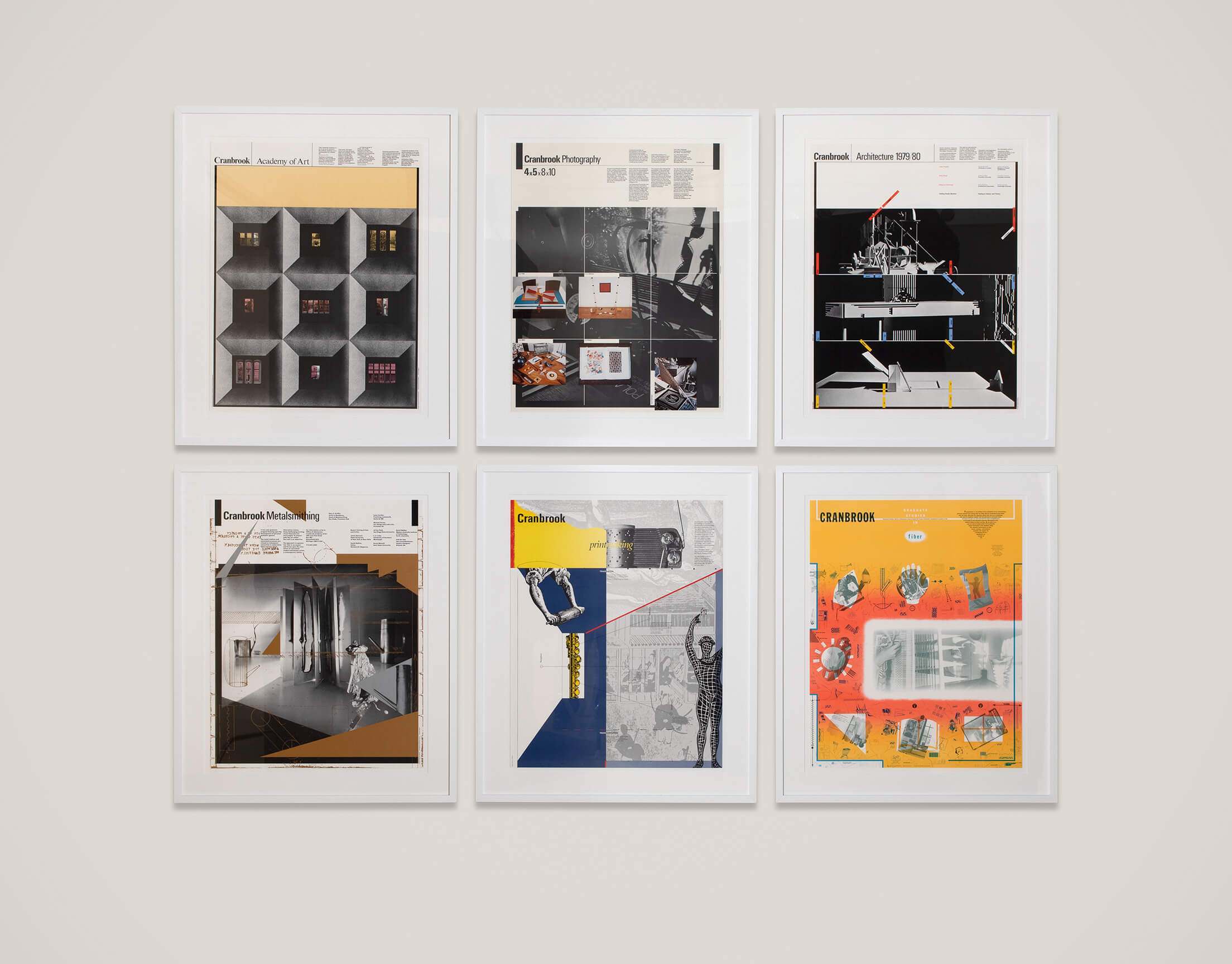
The reputation of the Academy’s influential graphic design program grew tremendously through its use of the medium from the 1970s through the 1990s under the tenure of designer-in-residence Katherine McCoy. The use of collage and photomontage techniques that layered provocative photography and illustration with progressive typography, decades before the desktop computer, can be seen in the promotional posters for Academy programs created by her and students of the design program in the 1970s and 1980s.
More oblique statements and personal messages dominated the poster work from designers in the 1980s and 1990s, and this tradition of experimental design continues with designer-in-residence Elliott Earls, whose prints, installations, and video work routinely crosses media and transcends disciplinary expectations.
Jim Miller-Melberg, who studied sculpture, supplied cast concrete playground features to parks around the country for decades through his company, Form. Millions of children have likely played on his iconic, mid-century designs that included abstract forms along with signature animals, such as his turtles, porpoises, and camels.
Cranbrook Art Museum is grateful to the following for their generous support of the exhibition and publication:
Major Sponsors
Sculpture Court Sponsor
Major Gallery Sponsors
Gallery and Artist Sponsors
In-Kind Sponsors
(as of May 7, 2021)
Christy Matson is a Los Angeles-based artist known for her painterly approach to textiles. Matson employs a hand-operated, computer-programmable Jacquard loom to create intricate weavings to which she often applies paint and other fiber techniques. The artist mines her deep interests in approaches such as collage and abstraction, which can be found in both historical as well as modernist textile traditions. Matson’s work reflects on the gendered histories of weaving in conjunction with art historical approaches such as geometric abstraction and collage.
Christy Matson: Crossings features 16 weavings configured into 2 monumentally scaled tapestries that were originally conceived for a special commission for the US Embassy in Ashgabat, Turkmenistan. Matson was struck by the affinities between the country’s textile traditions and the approach to color and composition in the functional textiles of the region more generally and her own work, including the use of both muted natural and saturated synthetic dyes and the collaging of different fabrics in the signature patchworked garments of the region. Additionally, Matson will present a selection of smaller recent works that continue her reflections on historic weave structures in conjunction with her unique approach to pastiche and collage.
Recent exhibitions by the artist have been held at the Long Beach Museum of Art, Craft and Folk Art Museum Los Angeles, Museum of Contemporary Arts Houston, The Milwaukee Art Museum, The Knoxville Museum of Art, the Asheville Museum of Art, and The San Francisco Museum of Craft+Design. Matson’s work is in the collections of the Art Institute of Chicago; the Smithsonian Museum of American Art’s Renwick Gallery in Washington, DC; and numerous corporate and private collections.
Christy Matson: Crossings was organized by Cranbrook Art Museum with the assistance of Volume Gallery, Chicago, and supported by the Maxine and Stuart Frankel Foundation, members of the Museum Committee, and ArtMembers of Cranbrook Art Museum.
This retrospective exhibition of the work of textile and interior designer Ruth Adler Schnee (b. 1923), still in active practice at age 96, affirms her pivotal role in the development of the modern interior. The exhibition presents at its core the body of textile patterns that Adler Schnee has created over the course of her prolific seven-decade career, including the screen-printed fabrics that helped define mid-century American modernism as well as their later translation into woven textiles. These designs become the filament that weaves throughout Adler Schnee’s professional networks, crossing between her and her husband’s retail entrepreneurship and her interior design commissions and architectural collaborations.
Born to a German Jewish family in Frankfurt, Germany, her mother’s Bauhaus training and creative circle of friends developed Adler Schnee’s interest in vibrant use of colors, rich textures, modern form, and the thoughtful study of architectural space from an early age. Following the Nazis’ Kristallnacht pogrom of 1938, the Adler family fled to the United States and settled in Detroit. First studying fashion design at Cass Technical High School and interior architecture at the Rhode Island School of Design, Adler Schnee received an MFA in Design from Cranbrook Academy of Art in 1946, becoming one of the first women to receive this degree. She went on to found a design consulting firm and modern design shop in Detroit with her husband Edward Schnee, launching a business which brought good design into important modern homes for over half a century.
Vintage textiles, archival drawings, and photography, and assorted ephemera, as well as her ongoing textile collaborations with companies such as Anzea Textiles and KnollTextiles, come together in an architectonic display to illuminate the underrepresented narrative of how women shaped the direction and reception of modernism in postwar America. The exhibition reveals her rigorous, iterative design processes and presents the more ephemeral residential and commercial interior design projects alongside the material through-line of her textiles.
An extensive 200-page publication accompanies the exhibition and situates Adler Schnee’s practice within her professional network of peers and collaborators—such as Alexander Girard, Jack Lenor Larsen, Angelo Testa, Albert Kahn, Eero Saarinen, and Minoru Yamasaki—while documenting her textile oeuvre and her fascinating life’s journey.
This exhibition is supported by the Graham Foundation for the Advanced Study in the Fine Arts.
Ruth Adler Schnee is organized by Cranbrook Art Museum and curated by Ian Gabriel Wilson, the Jeanne and Ralph Graham Collections Fellow. The exhibition is made possible with support from the Clannad Foundation and the Maxine and Stuart Frankel Foundation.
August 29, 1981
Cranbrook in 1946 was an enchanted place! A liberal European background and Beaux Arts training at the Rhode Island School of Design during wartime, hardly prepared me for it.
Harry Bertoia, Charles Eames, Ray Kaiser (later Eames), Florence Schust (later Knoll), and Harry Weese were no longer the all-star cast. But their spirit of experimental design, so enthusiastically fostered and promoted by the Saarinens, was still all-pervasive.
Ideas of using organic forms in design, coupled with new and untried materials in ingenious and revolutionary methods, were difficult to absorb. It took two months of the precious nine months of my fellowship period to make the personal adjustment. I deplored this loss of time. But once I realized that the “world was my oyster”: that there were no limitations except those posed by myself, I produced.
It was the most exhilarating experience to watch my work unfold from day to day.
Evenings at Saarinen House are long remembered. Discussion on design and creative processes were always the topic. Loja would be ensconced on a hard bench, cushioned by only one of her tapestries draped from the ceiling, across the bench and to the floor. Eliel sat on a stiff ceremonial chair of his own design. He was exceedingly comfortable there, so he always said. We students lounged at their feet.
There, I learned design discipline. I learned the philosophy which governs my entire life. In Eliel’s words, “Art and Design cannot be taught; it must be learned”.
Little did I realize then that the training and thoughts first formed at Cranbrook would make my life so very difficult, but so rewarding. They set standards by which I judge my work. And, to the frequent dismay of my husband and children, they often become the system of rules governing conduct. But they also serve to develop success.
I am a diligent designer. I love my craft and work hard at it, often late into the night. I am meticulous, making hundreds of sketches. I am proud of my design process. Saarinen and Cranbrook taught me so.
As I look back on thirty-five years of great pleasure and great agony in my chosen profession, I know that Saarinen and Cranbrook opened the doors to my lonely world. But it is a world so full of dynamism and exploded color that I hope to spend the rest of my life giving new direction to
Established concepts. Saarinen and Cranbrook taught me so.

Copyright © 2025 Cranbrook Art Museum. All rights reserved. Created by Media Genesis.